
RACHEL JAMES
How an abandoned farm became a garden

Anyone visiting the exposed and remote landscape of the Purbeck peninsula would hardly expect to come across a flower-filled garden, and certainly not one as exceptional as that created by Rachel James. Open fields stretch as far as the eye can see and run right to the edge of the cliffs, appearing to drop away into the sea. Green, blue and light grey are the predominant colours on this outer boundary of Dorset, where history is reflected in the names of its lanes and fields. The fields are punctuated with numerous small quarries where limestone has been excavated since time immemorial. This is where the Jurassic Coast begins – a UNESCO world heritage site – characterized by wonderful coastal formations. It is a region where harmony between the sea, landscape and craftsmen has prevailed for centuries.
Rachel James was brought up in Dorset, so later in life it was only natural for her to spend the summers on the coast with her young sons. In the 1980s, when the family began hunting for a holiday home, they were looking to buy a ‘lockup-and-leave’ property which could simply be left to its own devices between visits. However, sometimes a place proves so irresistible that common sense is pushed out of the equation, as was the case with Eastington Farm, located on Dorset’s Jurassic Coast. Thirty years ago, the adjectives ‘rustic’, ‘quaint’ and possibly ‘hopeless’ would have accurately described the property. The old farmhouse, a listed building dating from the sixteenth century, had been empty for years and was on the point of collapse. The landowner, the National Trust, had leased out the fields and was desperate to find someone interested in taking on this property and restoring it, along with the outbuildings, in a sensitive manner in line with the Trust’s aim of safeguarding and preserving the coastline of England.
‘Well, how could we say no,’ recalls Rachel James with a smile, since Eastington Farm is a seductive combination of history, sea views and matchless character. For Rachel James and her husband Allan it marked the start of decades of construction work as one building after another was renovated or, if necessary, demolished. Each step along the way had to be approved by the appropriate conservation bodies, from English Heritage to the local planners, as well as the National Trust of course, as it was vital that the site retained its understated character within the landscape and remained recognizable as a farm. Crucial to the success of the project was the involvement of local craftsmen, who had a deep knowledge of the building materials and an almost instinctive feel for them. One of these skilled Dorset craftsmen, Jack Cobb, turned up every weekend for some ten years and, under the watchful eye of his dog, laid stone upon stone as he constructed new walls and repaired old ones. For without this protective shield of dry-stone walls around the property, neither people nor plants would have stood a chance of survival against the wind.
SINGULAR ASH
As is often the case with farms in this sort of location, there was no garden to speak of. The site did, however, possess one major asset: there was a tree growing on the land, a rare phenomenon in a region where anything with an upright habit is flattened by the wind. Growing on the north side of the farmhouse and thus protected from the prevailing south-westerly winds, this magnificent ash (Fraxinus excelsior) with a low, broad crown seems – judging from its size – to feel happy here. It dominates the rectangular forecourt and whereas it used to be completely surrounded by an expanse of light-coloured gravel, it now stands in a generously proportioned circle of lawn. This was one of the first areas to be redesigned and marked the beginnings of the garden. Gravel has been used to cover the remaining surface, forming a turning circle and entrance to both the front and side door, but looks less harsh now that it occupies a smaller area and harmonizes well with the vegetation. Simplicity is the key to this area, with the tree and surrounding dry-stone walls defining the character of the place.
Walls divide up the land around and beyond the buildings, creating enclosures of varying size; despite their functional, even austere appearance, they have an undeniable aesthetic appeal of their own. And it is the walls that greet you at the gate. Flanking both sides of the drive, the parallel lines appear to squeeze the space, distorting its proportions and making the drive seem narrower and longer as it leads to the old farmyard. With the farmhouse to one side and the barns on the other, this area also appears larger than it is in reality. Narrow beds lining the walls are planted with an informal row of lacy, dark purple-leaved elder bushes (Sambucus nigra ‘Black Lace’), bringing colour and animation. Adjacent to this, separated only by a wall, lies the nucleus of the garden, the forecourt around the ash tree. This is the best place to start a tour of the garden; and it soon becomes clear that you are in exceptional surroundings. Here, the light greys that have predominated up to now give way to lush greens and whites. The details are subtle, verging on the understated. A rose climbs up the house wall and domes of box flank the ancient oak door. More box topiary is scattered along the wall, lying like discarded buoys, with occasional white stone-like spheres in between providing an additional eye-catching feature. This interplay between traditional and contemporary, rural and architectural elements, is a theme repeated throughout the garden.

Hidden away and protected by a spreading ash tree, there is no hint that this house is so close to the coast.
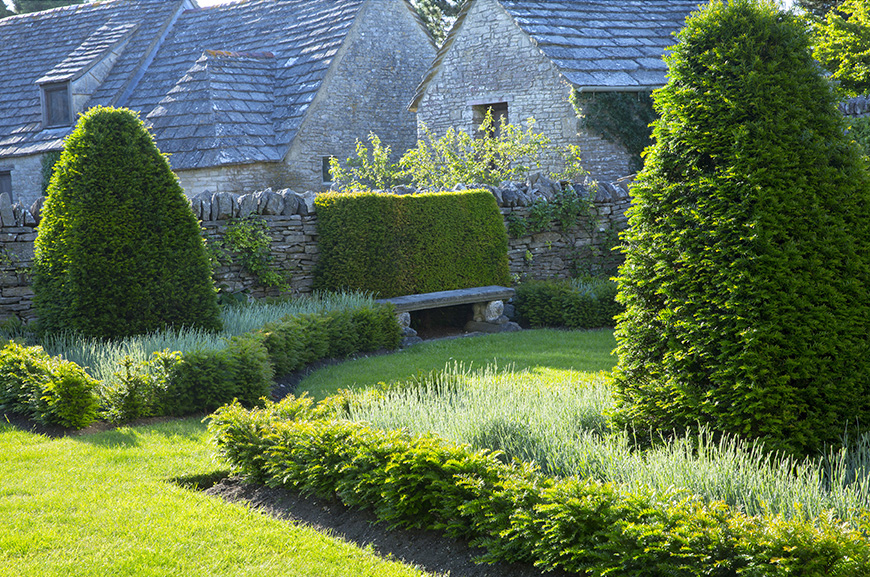
The secluded garden at the side of the house was the focus of some renewal work recently, as the box hedging had suffered in the salt winds. It was replaced with yew, which Rachel has learned is far more tolerant.
WALLED ENCLOSURES
Although not all the farm’s outbuildings could be preserved, their outer walls were nevertheless left standing and now form different garden enclosures. Wandering through these spaces from one garden room to another is a joy. Eastington Farm was always intended as an addition to the James’s London home, a place for the family to spend weekends and school holidays, so a tennis court was understandably high on the list of priorities. Hidden unobtrusively behind a high hedge, it is reached through a little garden filling the narrow space between the boundary wall and the outer wall of the old pigsty. Whereas the forecourt is cool and shaded, with a contemporary note, everything in this narrow flower garden is romantic, informal and awash with colour. Every shade of blue, pink and lilac is present in the clusters of catmint (Nepeta), different types of cranesbill (including Geranium ‘Philippe Vapelle’ and Geranium phaeum ‘Samobor’), roses, Allium aflatunense and much more, all set against the background of a perfect lawn. A small side path runs from here to an opening, beyond which lies an absolute dream of a garden.

Dry-stone walls, the remnants of an old farm, run through the grounds and provide protection for plants such as Rosa ‘Geranium’. Beyond the gap in the wall, the airy plumes of giant golden oats (Stipa gigantea) can be seen glowing in the sunshine.

The pond was part of the original farmyard, a reminder of the time when animals were brought here to drink. Now it is home to a family of ducks. The circular structure in the background is part of the Pool Garden, which like the walls was built using stone from local quarries.
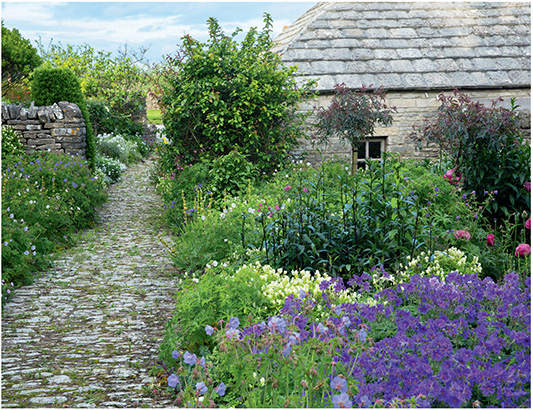
Geranium × magnificum along with G. clarkei ‘Kashmir White’ and G. pratense ‘Mrs Kendall Clark’ make a fitting frame for the view. Along the path, making the most of a narrow space, is the Rose Garden.
The Pool Garden belongs in the pages of an upmarket glossy magazine. Enclosed by high dry-stone walls – the remnants of the old pigsty – the transformation of this space is amazing. You could easily mistake this for the Mediterranean, thanks to the tower-like circular stone building resembling an ancient Sardinian nuraghe, and aromatic planting that includes germander (Teucrium chamaedrys), thyme and slender Italian cypresses (Cupressus sempervirens). The beautifully constructed dry-stone tower is an artwork in itself, but it is more than just a feature as it houses all the equipment needed for the swimming pool.
DESIGN TOUCHES
As at Sissinghurst, some parts of the garden function as links between different areas. The transition from the informal flow of the flower garden to the more formal Rose Garden is marked by a bronze statue. Gabrielle Peskin’s Venus of Kimmeridge Bay, inspired by driftwood, stands sentinel at a pivotal point in the garden. Both on a visual and symbolic level this sculpture is absolutely appropriate, as Rachel’s achievement in creating a garden in these difficult conditions is nothing short of an act of love. Prior to Eastington she was not a keen gardener; it was not that she was disinterested, but with two lively boys in tow she was simply too busy. It was only in the 1990s, when her children were older, that Rachel had time and was able to start thinking about the garden. It is easy to speculate, but one suspects that had she tackled the project earlier it might not have had the same self-assured flair, particularly in the way the spaces interconnect and flow.
Rachel’s idea of siting a rose garden in the long, narrow but sunny space sandwiched between the dry-stone wall in front of the tennis-court hedge and the long wall of the Pool Garden is pure genius. White and blue with a dash of yellow are the prevailing colours here. ‘Macmillan Nurse’ roses grown as standards – not ‘Iceberg’, as Rachel is quick to point out – line either side of the central cobblestone path. Rather than opting for a green background, of a hedge for example, as is so often the case in rose gardens, Rachel has kept with the limestone walls. A brave move, but the perfect foil for roses in a coastal garden. In this spot so close to the sea, colours appear intensely vibrant – an effect that calls for a bold approach. The Rose Garden acts like a corridor leading to the entrance drive, which seems, after the flourish of textures and colours, to be even more stark and monochrome.
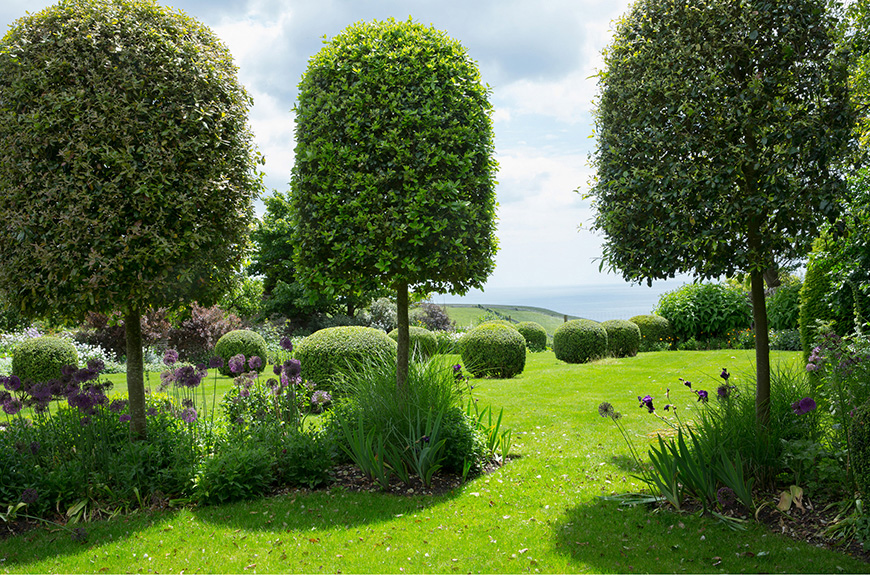
Distinctive lollipop-shaped holm oaks (Quercus ilex), with an underplanting of Iris and Allium, divide up the large lawn.
Eastington’s farmyard, reached along the drive, is not only surrounded by a cluster of buildings but is the site of a pond where livestock were once watered. Rachel and Allan thought long and hard about whether to fill in the irregularly shaped pond, but eventually decided not to because it is part of the farm’s agricultural heritage. So the leaks were repaired, but no other improvement work was carried out. The pond’s rustic charm contrasts beautifully with Rachel’s contemporary planting along the side of the barn, where pollarded willows are underplanted with Miscanthus sinensis ‘Gracillimus’, golden oats (Stipa gigantea) and switch grass (Panicum), from which tall spikes of orange foxtail lilies (Eremurus × isabellinus ‘Pinokkio’), Rachel’s favourite plant, thrust skyward. The rationale for this extravagant planting is tied to the fact that Rachel has an uninterrupted view of this area from her bedroom window. Against the pale grey stone and the generally blue sky, the straw-yellow, rust-brown and orange of the planting stand out particularly well. The wind breathes life into this part of the garden and adds another dimension to it.
WALLED GARDEN
At this juncture in the garden it is hard to believe there is still more to come. But a door set into a high wall next to the house leads into a small walled garden with four square lavender beds enclosed by low clipped hedging, each with a conically shaped yew rising out of them as a central feature. The feel here is more formal than the rest of the garden, although the effect is softened in typical country style by delphiniums, lambs’ tongue (Stachys byzantina) and climbing roses planted along the fringes of the house. Box had initially been used for the low hedges, but despite the sheltering walls they suffered from the constant salt-laden winds and have now been replaced with yew. It is astonishing that any plants can survive let alone flourish in such difficult conditions. Rachel’s energy and tenacity are part of the miracle, and an example to any gardener working in similarly difficult conditions.
Friends understand why Rachel is so firm about the route they should take through the garden. For on the other side of a door in the far corner of this formal garden lies Rachel’s pride and joy: an apple orchard that seamlessly flows into the surrounding landscape and is underplanted with a breathtaking sea of flowers. What an amazing blaze of colour – it feels like stepping into a painting by Claude Monet. Under a cornflower-blue sky, primary and secondary colours are splashed across the meadow: corn poppies (Papaver rhoeas), Icelandic poppies (Papaver nudicaule), cornflowers (Centaurea cyanus), love-in-a-mist (Nigella damascena), ox-eye daisies (Leucanthemum vulgare) and foxgloves (Digitalis purpurea) grow side by side in glorious, chaotic profusion. What is especially captivating, however, is the scene as a whole, best viewed from the elevated, fortress-like vantage point at the furthest extremity of the garden. The 360-degree panorama over the meadow bisected by the winding path and surrounded by countryside is magnificent. The flower meadow was far from simple to create and was achieved only after a false start. The flowers planted first time round refused to grow, for unlike the rest of the garden with its poor, chalky, free-draining soil, the soil here is too fertile. This was once the vegetable garden and had been enriched with compost and manure for generations, making it excellent for potatoes but not for growing meadow flowers. Weeds grew fast, stifled the delicate wild flowers and the experiment was a failure. Removing the rich soil would have been too time-consuming and costly, so Rachel decided on a different tack, assisted by Malcolm, her gardener at the time, and his wife Liz. The area was cleared, leaving the old fruit trees in place, and left fallow for a year. In this way they were able to get the intrusive weeds under control. The following spring, a mixture of annual and biennial seeds was scattered directly over the soil, and as if by magic the desired effect was achieved. The meadow has to be recreated afresh every year: mown after flowering, cleared in October, sown the following spring and bursting with flowers by July.
DELPHINIUM TIME
Over the years Rachel has learned the various strengths of her remarkable garden. In the early days her efforts were based more on luck than design, but now she knows which plants have a good chance of thriving and which do not. Her confident use of colour developed over time and she has learned to employ it to best advantage.
It is somehow fitting that the newest part of the garden abuts one of the oldest. This area is more cautiously designed, for it was here that she learned first to battle and then to work with the elements. It is in this section of the garden that the shape of the old farmhouse becomes apparent; it comprises two wings at right angles, one jutting out towards the coast, the other more protected and enclosing the space, with a direct view of the coast. A broad band of flagstones follows the contours of the building, creating a generous patio. Mexican fleabane (Erigeron karvinskianus) has invaded the joints and appears to tumble over into the beds lining the edge of the lawn. Rachel’s goal was to create an attractive setting for the house that consisted of more than lawn, and she has certainly achieved that. The picturesque house, perfect down to its window frames painted in subtly contrasting colours, now has the setting it deserves, one which also successfully integrates it with the broader landscape.
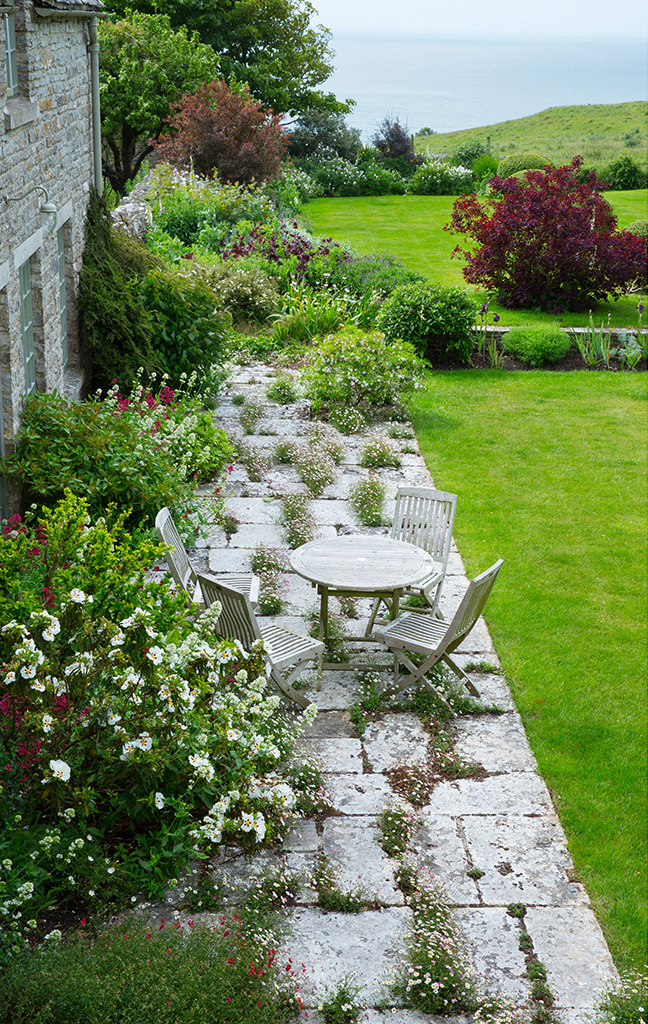
From the upper floor of the farmhouse, the sea appears to be a stone’s throw away. This is an optical illusion, however, as the garden is separated from the sea by a field and cliffs.
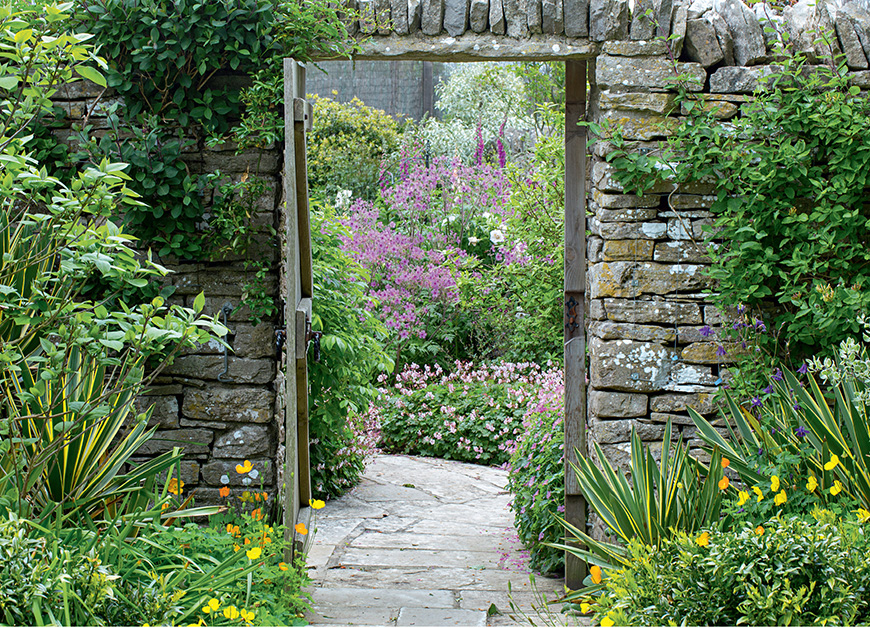
This maze-like garden has many elements of surprise, not least the ‘secret garden’ behind this doorway. The sight of pink geraniums greets you, but across the threshold you discover that this is where Rachel grows her herbs.
MARITIME CHALLENGE
Most people would have been more than happy simply to have a view of the sea, of fishing boats, yachts with white sails, and far off in the distance the tankers and container ships that daily cross the English Channel. On fine days, sky and water merge into a single, vast blue space which stands out sharply against the green of the fields. All the odds were against the planting of a garden in this exposed, wind-buffeted spot. But Rachel had other ideas: more than anything else, she wanted to tame the wind. And while she may not have tamed it altogether, she has adapted her gardening to withstand it. What gives the garden its edge is the interaction between the zesty colours of the planting schemes and the plain, dominant bulk of the walls. Each enhances the other in this innovative coastal garden.
GUIDING PRINCIPLES
|
By using local materials, building techniques and the vernacular style of the area for walls, structures and paving, the garden is integrated into the surroundings and is not intrusive. |
|
Wind protection is essential in a coastal garden. Where it is not possible to plant windbreaks it helps, as at Eastington, to divide the garden up into sections that can be sheltered by walls instead. |
|
Buying plants from local nurseries has many advantages: not only are the plants adapted to local conditions, but as Rachel James discovered at Holme Farm Plants, Wareham, nursery owners are a good source of advice for novice gardeners. |
|
Make sure the garden looks good when seen from the windows of the house, so you can enjoy it without going outside in inclement weather. |
SIGNATURE PLANTS
|
The wildflower meadow in the apple orchard, including poppies (Papaver rhoeas) and ox-eye daisies (Leucanthemum vulgare). |
|
Foxtail lilies such as orange Eremurus × isabellinus ‘Cleopatra’ planted with golden oats (Stipa gigantea). |
|
Bearded irises such as Iris ‘Deep Black’. |
|
Pink-flowered Canary Island geranium (Geranium palmatum) and cranesbills such as vivid purple-blue Geranium × magnificum. |
|
Evergreen architectural plants, such as box (Buxus sempervirens) and yew (Taxus baccata). |
